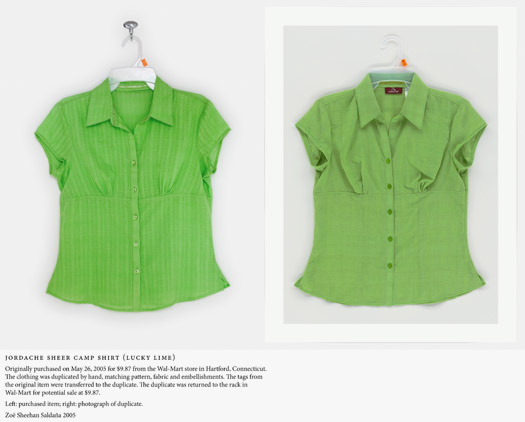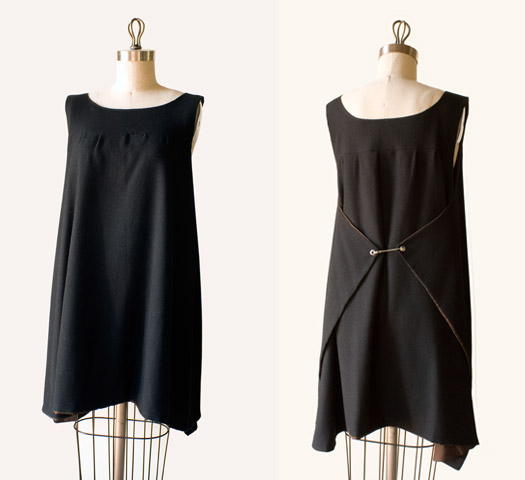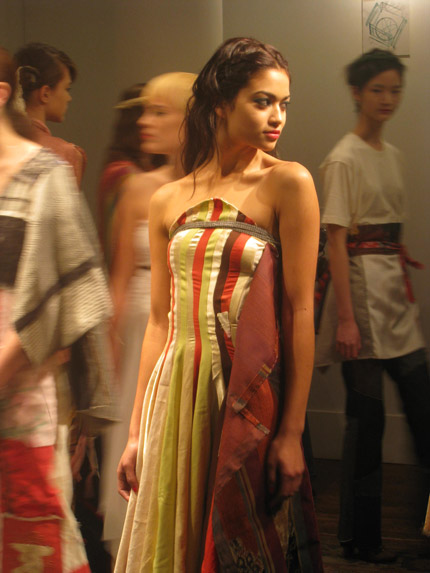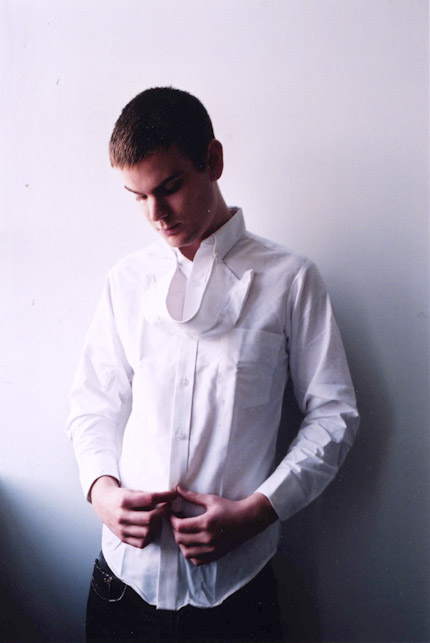
Zoë Sheehan Saldaña, Jordache Sheer Camp Shirt (Lucky Lime), 2005. Clothing, hanger, photographic print. Photos courtesy Pratt Manhattan Gallery
The anodyne math-equation title of Pratt Manhattan Gallery’s show “Ethics + Aesthetics = Sustainable Fashion” will likely discourage visitor traffic, as will its lack of street presence — it’s on the second floor at 144 W. 14th Street. But go climb the stairs before it closes on February 20. Young freelance curators Francesca Granata and Sarah Scaturro have produced a thought-provoking and downright fun survey of how American designers are trying to keep clothes and textiles out of the waste stream and involve fewer sweatshops, less pesticides and more DIY in the supply chain.
Granata and Scaturro, who teach respectively at Parsons and FIT, dreamed up the project four years ago. They pitched it to various venues before winning over Pratt (which has been incorporating more sustainability issues into the curriculum since 2005). From a shortlist of about 15 designers and artists, the curators chose 11, mainly in or near New York. (Two of them, Uluru and Susan Cianciolo, even operate out of the same Lower East Side loft.) The curators thus minimized shipping costs and carbon footprints while assembling about 60 prototypes, mass-produced outfits and fabric samples. “Some of these pieces were literally just walked over here,” Scaturro says.

The anodyne math-equation title of Pratt Manhattan Gallery’s show “Ethics + Aesthetics = Sustainable Fashion” will likely discourage visitor traffic, as will its lack of street presence — it’s on the second floor at 144 W. 14th Street. But go climb the stairs before it closes on February 20. Young freelance curators Francesca Granata and Sarah Scaturro have produced a thought-provoking and downright fun survey of how American designers are trying to keep clothes and textiles out of the waste stream and involve fewer sweatshops, less pesticides and more DIY in the supply chain.
Granata and Scaturro, who teach respectively at Parsons and FIT, dreamed up the project four years ago. They pitched it to various venues before winning over Pratt (which has been incorporating more sustainability issues into the curriculum since 2005). From a shortlist of about 15 designers and artists, the curators chose 11, mainly in or near New York. (Two of them, Uluru and Susan Cianciolo, even operate out of the same Lower East Side loft.) The curators thus minimized shipping costs and carbon footprints while assembling about 60 prototypes, mass-produced outfits and fabric samples. “Some of these pieces were literally just walked over here,” Scaturro says.

Andrea Zittel/Smockshop, smock based on an original pattern by Zittel. Wool, felted wool. Photo: Tiprin Follett
The installation budget was a shoestring: a dozen graduate students in an exhibit design class, taught by Jon Otis, devised and helped construct a crisscrossing-lumber ceiling mobile that dangles from cables. The clothes are on wooden hangers, rather than costly mannequins sealed in vitrines. (Scaturro, who is also a textile conservator at the Cooper-Hewitt, National Design Museum has invisibly reinforced the heavier garments with polyester strips and twill ties here and there, to reduce fabric stress during the exhibit run.) Calder mobiles inspired the crisscrossing wood, Granata explains, and the motif also “symbolizes the network of the designer, the systems that people don’t really notice, of making, selling and wearing clothes.” Since the outfits on view sway in open air, she adds, “The fact that they’re mobile in a sense makes them more interesting.”
Cotton scrims and plywood sheets divide the 11 designer samplings into three categories: Reduce, Revalue and Rethink. But the groups overlap too much for visitors to really sort out who belongs where; the exhibit variety just pops instead with colors, shapes and textures. Uluru’s overhaul of a vintage orange sweater, embroidered with an eerie vertebrae pattern, hangs near SANS’s baggy teal jumpsuit, a striped bikini from SUNO’s fair-wage workshop in Nairobi and a red-flowered hat and lime-green shirt that conceptual artist Zoë Sheehan Saldaña bought for a few dollars apiece at Wal-Mart and then hand-copied. She has put her own versions back on Wal-Mart racks with the original cheapo price tags. “Somebody unwittingly has her handmade shirt and hat,” Scaturro explains.

The installation budget was a shoestring: a dozen graduate students in an exhibit design class, taught by Jon Otis, devised and helped construct a crisscrossing-lumber ceiling mobile that dangles from cables. The clothes are on wooden hangers, rather than costly mannequins sealed in vitrines. (Scaturro, who is also a textile conservator at the Cooper-Hewitt, National Design Museum has invisibly reinforced the heavier garments with polyester strips and twill ties here and there, to reduce fabric stress during the exhibit run.) Calder mobiles inspired the crisscrossing wood, Granata explains, and the motif also “symbolizes the network of the designer, the systems that people don’t really notice, of making, selling and wearing clothes.” Since the outfits on view sway in open air, she adds, “The fact that they’re mobile in a sense makes them more interesting.”
Cotton scrims and plywood sheets divide the 11 designer samplings into three categories: Reduce, Revalue and Rethink. But the groups overlap too much for visitors to really sort out who belongs where; the exhibit variety just pops instead with colors, shapes and textures. Uluru’s overhaul of a vintage orange sweater, embroidered with an eerie vertebrae pattern, hangs near SANS’s baggy teal jumpsuit, a striped bikini from SUNO’s fair-wage workshop in Nairobi and a red-flowered hat and lime-green shirt that conceptual artist Zoë Sheehan Saldaña bought for a few dollars apiece at Wal-Mart and then hand-copied. She has put her own versions back on Wal-Mart racks with the original cheapo price tags. “Somebody unwittingly has her handmade shirt and hat,” Scaturro explains.

Susan Cianciolo, Striped Strapless Dress, Fall 2009. Organic cotton, bamboo, silk.


Slow and Steady Wins the Race, No. 8 Shirt, 2005. Cotton.
A few of the designers represented sell in bulk, or at least have attracted a great deal of media attention. Loomstate is a hot five-year-old manufacturer of organic cotton T-shirts and jeans, indie darling Slow and Steady Wins the Race collages buckles and chains on its cloth handbags in sarcastic homage to the likes of Gucci and Balenciaga, and Alabama Chanin has expanded its Alabama-sewn limited editions over the past few years into bridal gowns and pillow shams. The majority of the “Ethics + Aesthetics” objects, however, may remind viewers of suggestions from “No Impact Man.” Consumers will likely never take to Kelly Cobb’s itchy underwear made of locally harvested sheep’s wool, or hand over some favorite maternity blouses and babies’ onesies for Susan Cianciolo to patchwork into memory-stirring cocktail dresses, or follow Andrea Zittel’s precedent of wearing the same felt smock every day. (Copies of Zittel’s smock pattern will be included in the catalog, available in late January — in time for a free panel discussion on January 26 at Pratt — and funded by a $15,000 grant from the Coby Foundation.) Nor will it much affect the market if some craftsy people stitch their denim skirts from Cianciolo’s kits, which come complete with scissors, or follow SANS’s downloadable instructions for making T-shirts with smile-shaped neck openings.
The Pratt exhibit does not quite clarify how much of the clothing is actually on the market. In fact the wall texts often lack such basic details. The prose can get fuzzy and starstruck, praising companies that epitomize “American design at its best” or “foster the creation of meaningful networks and relations through clothing” or “affect positive and lasting social and economic change.” Yet we’re not told when and where all the designers were born and trained, what kinds of workshops and distribution and supplier networks they have set up and what their available pieces cost retail. (My advice to visitors: bring some handheld Googling device for getting up to speed on the fashion scene.)
So don’t go expecting a critical stance or some advice on what not to wear. “We didn’t want to espouse one solution, one approach to sustainability — there is no one overarching true thing,” Scaturro says. Go instead just to get heartened by experimental designers’ optimism, imagination, sewing skill and lack of preachiness. May this exhibit, with slightly juicier wall texts, travel widely, and may the students’ lumber ceiling mobile even inspire other exhibit installations, and maybe some recession-strapped or just thrifty boutique owners.
A few of the designers represented sell in bulk, or at least have attracted a great deal of media attention. Loomstate is a hot five-year-old manufacturer of organic cotton T-shirts and jeans, indie darling Slow and Steady Wins the Race collages buckles and chains on its cloth handbags in sarcastic homage to the likes of Gucci and Balenciaga, and Alabama Chanin has expanded its Alabama-sewn limited editions over the past few years into bridal gowns and pillow shams. The majority of the “Ethics + Aesthetics” objects, however, may remind viewers of suggestions from “No Impact Man.” Consumers will likely never take to Kelly Cobb’s itchy underwear made of locally harvested sheep’s wool, or hand over some favorite maternity blouses and babies’ onesies for Susan Cianciolo to patchwork into memory-stirring cocktail dresses, or follow Andrea Zittel’s precedent of wearing the same felt smock every day. (Copies of Zittel’s smock pattern will be included in the catalog, available in late January — in time for a free panel discussion on January 26 at Pratt — and funded by a $15,000 grant from the Coby Foundation.) Nor will it much affect the market if some craftsy people stitch their denim skirts from Cianciolo’s kits, which come complete with scissors, or follow SANS’s downloadable instructions for making T-shirts with smile-shaped neck openings.
The Pratt exhibit does not quite clarify how much of the clothing is actually on the market. In fact the wall texts often lack such basic details. The prose can get fuzzy and starstruck, praising companies that epitomize “American design at its best” or “foster the creation of meaningful networks and relations through clothing” or “affect positive and lasting social and economic change.” Yet we’re not told when and where all the designers were born and trained, what kinds of workshops and distribution and supplier networks they have set up and what their available pieces cost retail. (My advice to visitors: bring some handheld Googling device for getting up to speed on the fashion scene.)
So don’t go expecting a critical stance or some advice on what not to wear. “We didn’t want to espouse one solution, one approach to sustainability — there is no one overarching true thing,” Scaturro says. Go instead just to get heartened by experimental designers’ optimism, imagination, sewing skill and lack of preachiness. May this exhibit, with slightly juicier wall texts, travel widely, and may the students’ lumber ceiling mobile even inspire other exhibit installations, and maybe some recession-strapped or just thrifty boutique owners.


Comments [1]
12.18.09
11:12